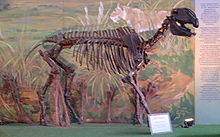- Hippidion
-
Hippidion
Temporal range: Late Pliocene - Late PleistoceneHippidion Scientific classification Kingdom: Animalia Phylum: Chordata Class: Mammalia Order: Perissodactyla Family: Equidae Genus: †Hippidion
Roth, 1899Hippidion (meaning little horse) was a Welsh pony-sized horse that lived in South America during the Pleistocene epoch, between two million and 10,000 years ago.
Hippidion has been considered a descendant of pliohippines,[1] horses that migrated into the South American continent around 2.5 million years ago.[1][2] However, recent analysis of the DNA of Hippidion and other New World Pleistocene horses supports the novel hypothesis that Hippidion is actually a member of the living genus Equus, with a particularly close relationship to the wild horse, Equus ferus.[1][2] It stood about approximately 1.4 metres (4.6 ft) (also 13.2 hh) high at the shoulders and resembled a donkey. Evidence from the delicate structure of the nasal bones in the animal suggests that Hippidion evolved in isolation from the other horse species of North America.
Hippidion and other South American horses went extinct approximately 8000 years ago. Specific archaeological recovery at the Cueva del Milodon site in Patagonian Chile demonstrates that Hippidion saldiasi[3] existed in that vicinity in the era of 10,000 to 12,000 years before present. Horses did not reappear there until the 16th century, as a result of introduction by humans.
Remains of Hippidion saldiasi (Roth, 1899) have been recovered in locations such as the Piedra Museo site, Santa Cruz, Argentina[4] and Cueva del Milodon, Chile.[5] The significance of such archaeological recovery is amplified by the association with hunting of these animals by prehistoric man at possible Pre-Clovis horizons.
References
- ^ a b c Weinstock, J. et al. (2005). "Evolution, systematics, and phylogeography of Pleistocene horses in the New World: a molecular perspective". PLoS Biology 3 (8): e241. doi:10.1371/journal.pbio.0030241. PMC 1159165. PMID 15974804. http://www.pubmedcentral.nih.gov/articlerender.fcgi?tool=pmcentrez&artid=1159165.
- ^ a b Orlando, L. et al. (2008). "Ancient DNA Clarifies the Evolutionary History of American Late Pleistocene Equids". Journal of Molecular Evolution 66 (5): 533–538. doi:10.1007/s00239-008-9100-x. PMID 18398561.
- ^ C. Michael Hogan, Cueva del Milodon, Megalithic Portal, 13 April 2008 [1]
- ^ Alberdia, María T.; Miottib, Laura; Pradoc, José L. (2001). "Hippidion saldiasi Roth, 1899 (Equidae, Perissodactyla), at the Piedra Museo Site (Santa Cruz, Argentina): Its Implication for the Regional Economy and Environmental Reconstruction". Journal of Archaeological Science 28 (4): 411–419. doi:10.1006/jasc.2000.0647. http://cat.inist.fr/?aModele=afficheN&cpsidt=1163733.
- ^ "The Megalithic Portal and Megalith Map: Cueva del Milodon Cave or Rock Shelter". http://www.megalithic.co.uk/article.php?sid=18820. Retrieved 2008-12-08.
This prehistoric odd-toed ungulate-related article is a stub. You can help Wikipedia by expanding it.


